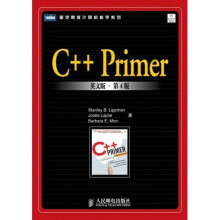C++Primer(英文版)(第4版)
作者:(美)李普曼,(美)拉菇瓦,(美)穆 著
出版:人民邮电出版社 2006.11
丛书:图灵原版计算机科学系列
页数:885
定价:99.00 元
ISBN-10:7115151695
ISBN-13:9787115151698
去豆瓣看看 Chapter 1 Getting Started
1.1 Writing a Simple C++Program
1.1.1 Compiling and Executing Our Program
1.2 A First Lookat Input/Output
1.2.1 Standard Input and Output Objects
1.2.2 A Program that Uses the IO Library
1.3 A Word About Comments
1.4 Control Structures
1.4.1 The while Statement
1.4.2 The for Statement
1.4.3 The if Statement
1.4.4 Reading an Unknown Number of Inputs
1.5 Introducing Classes
1.5.1 The Sales_item Class
1.5.2 A First Looka tMember Functions
1.6 The C++Program
Chapter Summary
Defined Terms
Part I The Basics
Chapter 2 Variables and Basic Types
2.1 Primitive Built-in Types
2.1.1 Integral Types
2.1.2 Floating-Point Types
2.2 Literal Constants
2.3 Variables
2.3.1 What Is a Variable?
2.3.2 The Name of a Variable
2.3.3 Defining Objects
2.3.4 Variable Initialization Rules
2.3.5 Declarations and Definitions
2.3.6 Scope of a Name
2.3.7 Define Variables Where They Are Used
2.4 const Qualifier
2.5 References
2.6 Typedef Names
2.7 Enumerations
2.8 Class Types
2.9 Writing Our Own Header Files
2.9.1 Designing Our Own Headers
2.9.2 A Brief Introduction to the Preprocessor
Chapter Summary
Defined Terms
Chapter 3 Library Types
3.1 Namespace using Declarations
3.2 Library stringType
3.2.1 Defining and Initializing strings
3.2.2 Reading and Writing strings
3.2.3 Operations on strings
3.2.4 Dealing with the Characters of a string
3.3 Library vector Type
3.3.1 Defining and Initializing vectors.
3.3.2 Operations on vectors
3.4 Introducing Iterators
3.4.1 Iterator Arithmetic
3.5 Library bitset Type
3.5.1 Defining and Initializing bitsets
3.5.2 Operations on bitsets
Chapter Summary
Defined Terms
Chapter 4 Arrays and Pointers
4.1 Arrays
4.1.1 Defining and Initializing Arrays
4.1.2 Operations on Arrays
4.2 Introducing Pointers
4.2.1 What Is aPointer?
4.2.2 Defining and Initializing Pointers
4.2.3 Operationson Pointers
4.2.4 Using Pointers to Access Array Elements
4.2.5 Pointers and the const Qualifier
4.3 C-Style Character Strings
4.3.1 Dynamically Allocating Arrays
4.3.2 Interfacing to Older Code
4.4 Multidimensioned Arrays
4.4.1 Pointers and Multidimensioned Arrays
Chapter Summary
Defined Terms
Chapter 5 Expressions
5.1 Arithmetic Operators
5.2 Relational and Logical Operators
5.3 The Bitwise Operators
5.3.1 Using bitset Objectsor Integral Values
5.3.2 Using the Shift Operators for IO
5.4 Assignment Operators
5.4.1 Assignment Is Right Associative
5.4.2 Assignment Has Low Precedence
5.4.3 Compound Assignment Operators
5.5 Increment and Decrement Operators
5.6 The Arrow Operator
5.7 The Conditional Operator
5.8 The size of Operator
5.9 Comma Operator
5.10 Evaluating Compound Expressions
5.10.1 Precedence
5.10.2 Associativity
5.10.3 Order of Evaluation
5.11 The new and delete Expressions
5.12 Type Conversions
5.12.1 When Implicit Type Conversions Occur
5.12.2 The Arithmetic Conversions
5.12.3 Other Implicit Conversions
5.12.4 Explicit Conversions
5.12.5 When Casts Might Be Useful
5.12.6 Named Casts
5.12.7 Old-StyleCasts
Chapter Summary
Defined Terms
Chapter 6 Statements
6.1 Simple Statements
6.2 Declaration Statements
6.3 Compound Statements (Blocks)
6.4 Statement Scope
6.5 The if Statement
6.5.1 The if Statement else Branch
6.6 The switch Statement
6.6.1 Using a switch
6.6.2 Control Flow within a switch
6.6.3 The default Label
6.6.4 switch Expression and CaseLabels
6.6.5 Variable Definitions inside a switch
6.7 The while Statement
6.8 The forLoop Statement
6.8.1 Omitting Parts of the for Header
6.8.2 Multiple Definitions in the for Header
6.9 The do while Statement
6.10 The break Statement
6.11 The continue Statement
6.12 The goto Statement
6.13 try Blocks and Exception Handling
6.13.1 A throw Expression
6.13.2 The try Block
6.13.3 Standard Exceptions
6.14 Using the Preprocessor for Debugging
Chapter Summary
Defined Terms
Chapter 7 Functions
Chapter 8 The IO Library
Part II Containers and Algorithms
Chapter 9 Sequential Containers
Chapter 10 Associative Containers
Chapter 11 Generic Algorithms
Part III Classes and Data Abstraction
Chapter 12 Classes
Chapter 13 Copy Control
Chapter 14 Overloaded Operations and Conversions
Part Ⅳ Object-Oriented and Generic Programming
Chapter 15 Object-Oriented Programming
Chapter 16 Templates and Generic Programming
Part Ⅴ Advanced Topics
Chapter 17 Tools for Large Programs
Chapter 18 Specialized Tools and Techniques
AppendixA The Library
Index
Stanley B. Lippman,目前是微软公司 Visual C++ 团队的架构师。他从1984年开始在贝尔实验室与C++的设计者Bjarne Stroustrup一起从事C++的设计与开发。又先后在迪士尼和梦工厂从事动画制作,还担任过JPL的高级顾问。他还著有Inside the C++ Object Model。
“在遇到无法解决的问题时,我总会求助于C++ Primer一书。”——Bruce·Eckel,“编程思想”系列图书作者
“众所周知, C++ Primer是学习C++理想的参考书之一,适用于各种水平的C++程序员。第4版不但保持了这种传统,而且有了很大改善。”——STEVE?VINOSKI,IONA科技公司首席工程师,CORBA与C++专家。
“《C++Primer(英文版)(第4版)》真正揭示了C++这一大型、复杂语言的本质。”——JUSTIN?SHAW,Aerospace公司电子程序部技术处资深成员
“(本书)不但使初学者迅速入门,而且是用优秀的编程实践引导他们入门。”——NEVIN?LIBER,资深工程师(自1988年起一直是C++开发者)
C++诞生20年后,因其强大的功能、广泛的适用性和极高的效率,已经成为无庸置疑的主流编程语言。但是C++语言也不得不面对这样的挑战:其博大精深不仅令初学者望而生畏,而且即使是许多富于经验的老手也很难全面掌握,更有不少C++程序员一直背负着C语言的历史包袱,常常落入各种微妙难解的安全和性能陷阱。如何使现代C++理念深入人心,使C++更加容易学习和使用,已经成为众所瞩目的焦点。
《C++Primer(英文版)(第4版)》是久负盛名的C++经典教程,已经帮助全球无数程序员学会了C++。这一全新版本进行了彻底的修订,章节内容和编排都经过了重新组织,既显著改善了可读性,又充分体现了C++语言的新进展和当前的业界优秀实践。《C++Primer》(英文版)(第4版)(图灵原版计算机科学系列)是C++大师Stan?B?Lippman丰富的实践经验和C++标准委员会原负责人Josée·Lajoie对C++标准深入理解的完美结合。新版更加入了C++先驱Barbara?E?Moo在C++教学方面的真知灼见。对C++基本概念和技术全面而且专家的阐述,对现代C++编程风格的强调,使本书不仅依然是初学者的优秀C++指南,而且即使对于中高级程序员,本书也是不可或缺的参考书。
比价列表








 缺书网
缺书网 扫码进群
扫码进群